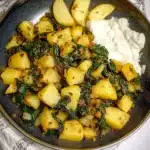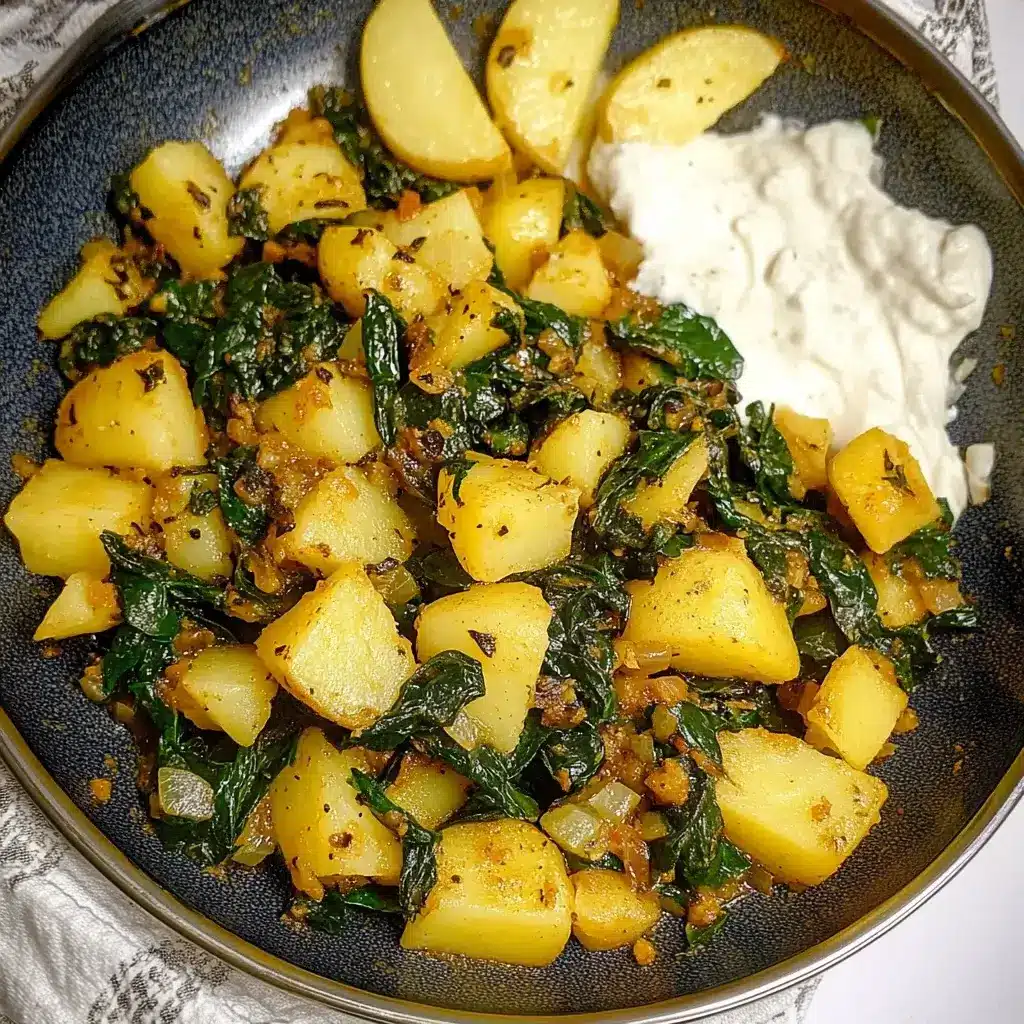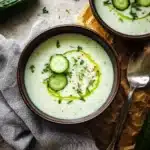This Sauteed Spinach and Potatoes recipe has become an absolute staple in my kitchen, a delightful surprise the first time I whipped it up on a busy weeknight. I was looking for something simple, comforting, yet reasonably healthy to use up the bag of spinach threatening to wilt in the fridge and the few potatoes rolling around in the pantry. Honestly, my expectations weren’t sky-high – potatoes and spinach, how exciting could it be? But the aroma that filled the kitchen as the garlic hit the hot oil and the potatoes started to crisp up was the first hint I was onto something special. The magic truly happened when the vibrant green spinach wilted down, mingling with the golden potatoes. The result was far greater than the sum of its parts: tender, slightly crisp potatoes, silky spinach, all coated in garlicky goodness. My family, including my usually veggie-skeptic teenager, devoured it. Requests for “those yummy potatoes and greens” started popping up regularly. It’s become my go-to side dish for everything from roasted chicken to grilled fish, and sometimes, topped with a fried egg, it even stars as a quick and satisfying lunch. Its simplicity is deceptive; the flavour is robust, comforting, and utterly delicious. It’s proof that you don’t need complicated techniques or fancy ingredients to create truly memorable food.
A Match Made in Simple Heaven: Why This Sauteed Spinach and Potato Recipe Works
Before we dive into the specifics, let’s talk about why this combination is so universally appealing and why this particular recipe has become such a favorite. There’s a certain culinary alchemy that happens when humble potatoes meet leafy spinach, elevated by the simple magic of garlic and good olive oil.
Firstly, Texture Contrast: This dish is a masterclass in texture. You get the satisfyingly tender, slightly fluffy interior of the potato contrasted with its beautifully crisped, golden-brown edges from the sautéing process. Then comes the spinach – wilted down to a silky, almost creamy consistency that wraps around the potatoes. It’s a delightful interplay in every mouthful, preventing the dish from becoming monotonous.
Secondly, Flavor Harmony: Potatoes offer a mild, earthy, slightly sweet base – a perfect canvas. Spinach brings a subtle minerality and a fresh, ‘green’ flavour that cuts through the starchiness of the potatoes. Garlic, the aromatic powerhouse, bridges these two ingredients beautifully, adding a pungent warmth that permeates the entire dish. Good quality olive oil contributes its own fruity notes and richness. Salt and pepper are crucial for enhancing these inherent flavours, making everything pop.
Thirdly, Nutritional Balance: While undeniably comfort food, this dish packs a decent nutritional punch. Potatoes provide complex carbohydrates for energy, potassium, and Vitamin C. Spinach is a nutritional superstar, loaded with iron, Vitamin K, Vitamin A, folate, and antioxidants. Using olive oil adds healthy monounsaturated fats. It’s a far more balanced side dish than many traditional options, offering both satisfaction and nourishment.
Fourthly, Incredible Versatility: As mentioned in the introduction, this recipe is a chameleon. It’s hearty enough to be a vegetarian main course (especially with additions like beans, eggs, or cheese) but also perfectly complements a vast array of proteins. It fits seamlessly alongside roasted meats, grilled fish, sausages, or even tofu steaks. It can be dressed up with herbs and spices or kept beautifully simple.
Fifthly, Simplicity and Accessibility: This is not chef-level cooking. The ingredients are readily available in almost any supermarket, and they are generally inexpensive. The techniques involved – chopping, boiling (optional, depending on preference and potato type), and sautéing – are fundamental cooking skills that are easy to master. It’s achievable for novice cooks yet satisfying for experienced ones.
Finally, Crowd-Pleasing Appeal: There’s something universally comforting about potatoes. Combined with the visually appealing green of the spinach and the irresistible aroma of garlic, it’s a dish that tends to win over even picky eaters. It feels wholesome, looks appetizing, and delivers on flavour, making it a reliable choice whether you’re cooking for yourself, your family, or guests.
Understanding these core elements helps appreciate why such a simple concept yields such a rewarding result. It’s a testament to how well-chosen ingredients, cooked with straightforward techniques, can create something truly delicious and satisfying.
Ingredients You’ll Need for Sauteed Spinach and Potatoes
Gathering the right ingredients is the first step towards culinary success. Precision isn’t always paramount in rustic dishes like this, but using good quality components makes a difference. Here’s what you’ll need:
- Potatoes: 1.5 lbs (about 680g) Yukon Gold or red potatoes (about 3-4 medium potatoes). These waxy varieties hold their shape well when cooked and develop a lovely creamy interior and crisp exterior. Russets can work but tend to fall apart more easily.
- Fresh Spinach: 10 oz (about 280g) fresh baby spinach or mature spinach, tough stems removed. This seems like a lot, but it wilts down significantly.
- Olive Oil: 3 tablespoons extra virgin olive oil, plus potentially a little more if needed. Choose a decent quality oil as its flavour contributes to the dish.
- Garlic: 4-5 cloves garlic, minced or thinly sliced. Adjust amount based on your love for garlic! Fresh garlic offers the best flavour.
- Salt: 1 teaspoon kosher salt or sea salt, or to taste. Use more if needed, especially for seasoning the potatoes initially.
- Black Pepper: 1/2 teaspoon freshly ground black pepper, or to taste. Freshly ground makes a noticeable difference.
- Optional: Red Pepper Flakes: 1/4 – 1/2 teaspoon (optional, for a touch of heat).
- Optional: Fresh Lemon Juice: A small squeeze at the end (optional, brightens flavours).
- Optional: Grated Parmesan Cheese: For serving (optional).
A Note on Ingredient Choices:
- Potatoes: While Yukon Gold or red potatoes are recommended for their waxy texture, you can use Russets or other starchy potatoes. If using starchy potatoes, be gentler when stirring to prevent them from breaking down too much. Cutting them slightly larger can also help them maintain integrity. Thoroughly washing and scrubbing the potatoes is essential, and you can choose to peel them or leave the skins on for extra texture and nutrients (especially with thinner-skinned varieties like red potatoes or Yukon Golds). Ensure they are cut into uniform pieces (around 3/4 to 1-inch cubes) for even cooking.
- Spinach: Baby spinach is convenient as it requires minimal prep. If using mature spinach (larger leaves), make sure to wash it thoroughly to remove any grit and remove the thick, tough stems before chopping the leaves roughly. Frozen spinach can be substituted in a pinch (see FAQ section for details).
- Garlic: The intensity of garlic flavour depends on how finely it’s processed and when it’s added. Minced garlic distributes more widely and cooks faster. Thinly sliced garlic offers little pockets of flavour. Adding it later in the cooking process preserves more of its pungent flavour, while adding it earlier mellows it. For this recipe, adding it after the potatoes have had a head start prevents it from burning while allowing its flavour to infuse the oil.
Step-by-Step Instructions: Cooking Sauteed Spinach and Potatoes to Perfection
Follow these steps carefully for the best results. The key is patience – allowing the potatoes to brown properly and managing the moisture from the spinach.
- Prepare the Potatoes: Wash and scrub the potatoes thoroughly. Peel them if desired, or leave the skin on for a more rustic feel and added nutrients. Cut the potatoes into uniform cubes, approximately 3/4-inch to 1-inch in size. Consistency in size is crucial for even cooking – you don’t want small bits burning while larger pieces are still raw. Rinse the cut potatoes under cold water to remove excess surface starch (this helps them crisp up better) and pat them thoroughly dry with paper towels. Excess moisture will cause the oil to splatter and will steam the potatoes instead of browning them.
- Prepare the Spinach and Garlic: If using mature spinach, wash it well and remove any thick stems. Roughly chop the leaves. If using baby spinach, give it a quick rinse and ensure it’s reasonably dry (a salad spinner works well). Peel and mince or thinly slice the garlic cloves. Set aside.
- Start Cooking the Potatoes: Heat the 3 tablespoons of olive oil in a large, heavy-bottomed skillet or frying pan (cast iron works wonderfully here) over medium-high heat. The pan needs to be large enough to hold the potatoes in mostly a single layer – overcrowding will lead to steaming. Once the oil is shimmering (hot but not smoking), carefully add the dried potato cubes. Spread them out in an even layer.
- Brown the Potatoes: Let the potatoes cook undisturbed for about 5-7 minutes, allowing them to develop a golden-brown crust on the bottom. This initial searing is key for texture. Season generously with about 3/4 teaspoon of the salt and 1/4 teaspoon of the black pepper.
- Continue Cooking Potatoes: Reduce the heat slightly to medium. Stir the potatoes, turning them to brown the other sides. Continue cooking, stirring occasionally, for another 15-20 minutes, or until the potatoes are tender when pierced with a fork and nicely browned and crisped on multiple sides. Adjust the heat as needed – if they are browning too quickly, lower the heat; if they are not browning, increase it slightly. Be patient during this stage; good browning takes time. If the pan seems dry, you can add another drizzle of olive oil.
- Add the Garlic (and Optional Heat): Once the potatoes are nearly tender and well-browned, push them to one side of the skillet. Add the minced or sliced garlic (and red pepper flakes, if using) to the cleared space in the pan. Cook for about 30-60 seconds, stirring constantly, until the garlic is fragrant. Be very careful not to burn the garlic, as it will become bitter.
- Incorporate the Garlic: Stir the fragrant garlic into the potatoes, ensuring it’s well distributed. Cook for another minute, allowing the flavours to meld.
- Wilt the Spinach: Add the fresh spinach to the skillet on top of the potatoes. It might seem like a huge amount, but it will wilt down quickly. If necessary, add the spinach in batches. Cover the skillet for a minute or two to help the spinach wilt from the steam.
- Combine and Finish: Once the spinach has started to wilt, gently stir it into the potatoes. Continue to cook, stirring occasionally, for another 2-4 minutes, until the spinach is fully wilted and tender, and any excess moisture released by the spinach has mostly evaporated.
- Season and Serve: Taste the mixture and adjust seasoning as needed, adding the remaining 1/4 teaspoon salt and 1/4 teaspoon black pepper, or more, to your preference. If using, stir in a small squeeze of fresh lemon juice right at the end to brighten the flavours. Serve immediately, garnished with optional grated Parmesan cheese if desired.
Nutritional Information (Estimated)
Please note that these values are approximate and can vary based on the specific ingredients used (size of potatoes, amount of oil absorbed, etc.). This estimation assumes the recipe serves 4 people as a side dish.
- Servings: 4
- Calories per serving: Approximately 280-350 kcal
Breakdown:
- The majority of the calories come from the potatoes (carbohydrates) and the olive oil (fats).
- Spinach contributes relatively few calories but adds significant vitamins and minerals, particularly iron, Vitamin K, Vitamin A, and folate.
- Potatoes provide potassium, Vitamin C, and fiber (especially if skin-on).
- Garlic offers trace minerals and beneficial compounds.
- Olive oil provides healthy monounsaturated fats.
This dish offers a good balance of macronutrients (carbohydrates, fats, and some protein from the vegetables) and is rich in several essential micronutrients. It’s a reasonably healthy and satisfying option, particularly when compared to cream-based or heavily fried side dishes. For a lower-calorie version, you can slightly reduce the amount of olive oil used, potentially employing a good non-stick pan, but be mindful that oil is crucial for flavour and crisping the potatoes.
Preparation and Cooking Time
Understanding the time commitment helps plan your meal preparation effectively.
- Preparation Time: Approximately 15 minutes (Washing, scrubbing, peeling (if desired), dicing potatoes, rinsing/prepping spinach, mincing garlic).
- Cooking Time: Approximately 25-30 minutes (Sautéing potatoes until tender and browned, cooking garlic, wilting spinach).
- Total Time: Approximately 40-45 minutes
This timing makes it feasible for a weeknight meal, especially if you prep the potatoes or garlic slightly ahead of time (though potatoes are best cut just before cooking to prevent browning).
How to Serve Your Delicious Sauteed Spinach and Potatoes
This versatile dish can be served in numerous ways. Here are some ideas:
- As a Classic Side Dish: This is its most common role. It pairs beautifully with:
- Roasted Meats: Chicken, pork loin, beef roast. The earthy flavours complement the richness of the meat.
- Grilled Items: Steak, fish (salmon, cod, halibut), chicken breasts, sausages. The slight char from grilling works well with the sautéed vegetables.
- Pan-Seared Proteins: Pork chops, chicken cutlets, fish fillets.
- Simple Baked Fish: Provides a flavourful and textural contrast to plainly cooked fish.
- As a Hearty Vegetarian or Vegan Main Course:
- Top with one or two fried or poached eggs. The runny yolk creates a delicious sauce.
- Stir in a can of drained and rinsed chickpeas or white beans during the last few minutes of cooking for added protein and fiber.
- Serve alongside baked tofu or tempeh.
- Simply enjoy a larger portion on its own for a satisfying, plant-based meal.
- For Brunch:
- Serve as a component of a larger brunch spread.
- Use it as a base for a breakfast hash, perhaps adding some crumbled bacon or sausage.
- With Added Toppings and Flavours:
- Sprinkle generously with grated Parmesan or Pecorino Romano cheese just before serving for a salty, umami kick.
- Crumble some feta cheese over the top for a tangy contrast.
- Add a dollop of plain Greek yogurt or sour cream for creaminess.
- Sprinkle with toasted nuts or seeds (like pine nuts, sunflower seeds, or chopped walnuts) for extra crunch.
- Garnish with fresh herbs like chopped parsley, chives, or dill.
- A drizzle of balsamic glaze can add a touch of sweetness and acidity.
Pro Tips for Elevating Your Sauteed Spinach and Potatoes
Take your dish from great to absolutely outstanding with these simple tips:
- Choose the Right Potato (and Prep it Well): As mentioned, waxy potatoes like Yukon Gold, Red Bliss, or Fingerlings are ideal. They hold their shape during sautéing and develop a creamy interior without turning mushy. Crucially, pat the potatoes completely dry after rinsing. Wet potatoes will steam instead of crisping, preventing that desirable golden-brown crust. Don’t skip this step!
- Don’t Crowd the Pan: This is arguably the most important tip for achieving crispy potatoes. Use a large enough skillet so the potatoes can sit in mostly a single layer with some space between them. If you overcrowd the pan, the temperature will drop, and the potatoes will release moisture, effectively steaming themselves. If your skillet isn’t large enough, cook the potatoes in two batches. It takes longer, but the crispy result is worth it.
- Manage Spinach Moisture: Fresh spinach releases a fair amount of water as it wilts. To avoid a soggy dish, ensure the potatoes are nicely browned and slightly crisped before adding the spinach. Allow the spinach to wilt fully and cook for a minute or two longer than you might think, stirring, to let most of that excess liquid evaporate. If using frozen spinach, it’s absolutely essential to thaw it completely and squeeze out as much water as physically possible before adding it to the pan.
- Garlic Timing is Key: Burnt garlic tastes acrid and unpleasant, ruining the dish. Add the minced or sliced garlic only during the last couple of minutes of the potatoes’ cooking time, just before adding the spinach. Sauté it briefly in the oil until fragrant (usually 30-60 seconds) before mixing it with the potatoes. This infuses the dish with flavour without risking bitterness.
- Experiment with Flavour Boosters: While delicious on its own, this dish welcomes additions. A squeeze of fresh lemon juice or a splash of white wine vinegar added right at the end brightens everything up beautifully. Consider adding complementary herbs like rosemary or thyme along with the potatoes (add hardy herbs early, tender herbs like parsley at the end). A pinch of smoked paprika adds depth. Don’t underestimate the power of good quality salt and freshly ground black pepper – season adequately!
Frequently Asked Questions (FAQ) about Sauteed Spinach and Potatoes
Here are answers to some common questions about making this recipe:
- Q: Can I use frozen spinach instead of fresh?
- A: Yes, you absolutely can use frozen spinach, which is often more convenient and budget-friendly. However, it requires proper handling. You’ll need about a 10-ounce package of frozen chopped spinach. The crucial step is to thaw it completely and then squeeze out as much excess water as possible. You can do this by placing the thawed spinach in a clean kitchen towel or several layers of paper towels and wringing it out forcefully over the sink. Add the squeezed, thawed spinach to the pan after the garlic has become fragrant, just as you would with fresh spinach, and cook until heated through, ensuring any remaining moisture evaporates. The texture might be slightly softer than with fresh spinach, but the flavour will still be great.
- Q: What are the best types of potatoes for this recipe?
- A: Waxy potatoes are generally preferred because they hold their shape well when cooked and have a creamy texture. Good choices include Yukon Gold, Red Potatoes (Red Bliss, Pontiac), Fingerlings, or New Potatoes. These varieties become tender but don’t easily disintegrate into mush during sautéing. While you can use starchy potatoes like Russets (Idaho), be aware they are more likely to break apart. If using Russets, cut them into slightly larger cubes and handle them more gently when stirring.
- Q: How do I store and reheat leftovers?
- A: Store any leftovers in an airtight container in the refrigerator for up to 3-4 days. To reheat, avoid the microwave if possible, as it tends to make the potatoes soft and the spinach slightly rubbery. The best methods are:
- Stovetop: Reheat gently in a skillet over medium-low heat with a tiny bit of extra olive oil until warmed through. This helps to refresh the texture.
- Oven/Toaster Oven: Spread the leftovers on a baking sheet and reheat in a preheated oven at around 350°F (175°C) for 10-15 minutes, or until hot. This method does a good job of reviving some crispness.
- A: Store any leftovers in an airtight container in the refrigerator for up to 3-4 days. To reheat, avoid the microwave if possible, as it tends to make the potatoes soft and the spinach slightly rubbery. The best methods are:
- Q: Can I make this Sauteed Spinach and Potatoes recipe vegan?
- A: Yes, this recipe is easily made vegan as its core ingredients (potatoes, spinach, garlic, olive oil, salt, pepper) are all plant-based. Just ensure you are using olive oil or another vegetable oil and omit any optional dairy toppings like Parmesan cheese. If you want a creamy or cheesy element, consider adding nutritional yeast at the end or using a sprinkle of vegan Parmesan alternative.
- Q: Can I add other vegetables or ingredients to this dish?
- A: Absolutely! This recipe is very adaptable. Consider adding:
- Onions or Shallots: Slice thinly and add them to the pan a few minutes after the potatoes have started cooking, allowing them to soften and caramelize slightly.
- Bell Peppers: Dice any color bell pepper and add them about 10 minutes into the potato cooking time so they become tender-crisp.
- Mushrooms: Sliced mushrooms can be added alongside the garlic, or cooked separately and stirred in at the end to prevent them from releasing too much water early on.
- Zucchini or Summer Squash: Dice and add during the last 5-7 minutes of potato cooking time.
- Protein: Cooked bacon lardons (added early), diced cooked sausage, or canned chickpeas/white beans (added near the end) can make it a more substantial meal. Experiment and see what combinations you enjoy!
- A: Absolutely! This recipe is very adaptable. Consider adding:
This Sauteed Spinach and Potatoes recipe is more than just a side dish; it’s a versatile, flavorful, and comforting staple that proves simple ingredients, cooked well, can be incredibly satisfying. Whether you’re a seasoned cook or just starting, this recipe is approachable and consistently delivers delicious results. Give it a try – it might just become a new favorite in your household too!
Print
Sauteed Spinach and Potatoes recipe
Ingredients
-
- Potatoes: 1.5 lbs (about 680g) Yukon Gold or red potatoes (about 3-4 medium potatoes). These waxy varieties hold their shape well when cooked and develop a lovely creamy interior and crisp exterior. Russets can work but tend to fall apart more easily.
-
- Fresh Spinach: 10 oz (about 280g) fresh baby spinach or mature spinach, tough stems removed. This seems like a lot, but it wilts down significantly.
-
- Olive Oil: 3 tablespoons extra virgin olive oil, plus potentially a little more if needed. Choose a decent quality oil as its flavour contributes to the dish.
-
- Garlic: 4-5 cloves garlic, minced or thinly sliced. Adjust amount based on your love for garlic! Fresh garlic offers the best flavour.
-
- Salt: 1 teaspoon kosher salt or sea salt, or to taste. Use more if needed, especially for seasoning the potatoes initially.
-
- Black Pepper: 1/2 teaspoon freshly ground black pepper, or to taste. Freshly ground makes a noticeable difference.
-
- Optional: Red Pepper Flakes: 1/4 – 1/2 teaspoon (optional, for a touch of heat).
-
- Optional: Fresh Lemon Juice: A small squeeze at the end (optional, brightens flavours).
-
- Optional: Grated Parmesan Cheese: For serving (optional).
A Note on Ingredient Choices:
-
- Potatoes: While Yukon Gold or red potatoes are recommended for their waxy texture, you can use Russets or other starchy potatoes. If using starchy potatoes, be gentler when stirring to prevent them from breaking down too much. Cutting them slightly larger can also help them maintain integrity. Thoroughly washing and scrubbing the potatoes is essential, and you can choose to peel them or leave the skins on for extra texture and nutrients (especially with thinner-skinned varieties like red potatoes or Yukon Golds). Ensure they are cut into uniform pieces (around 3/4 to 1-inch cubes) for even cooking.
-
- Spinach: Baby spinach is convenient as it requires minimal prep. If using mature spinach (larger leaves), make sure to wash it thoroughly to remove any grit and remove the thick, tough stems before chopping the leaves roughly. Frozen spinach can be substituted in a pinch (see FAQ section for details).
-
- Garlic: The intensity of garlic flavour depends on how finely it’s processed and when it’s added. Minced garlic distributes more widely and cooks faster. Thinly sliced garlic offers little pockets of flavour. Adding it later in the cooking process preserves more of its pungent flavour, while adding it earlier mellows it. For this recipe, adding it after the potatoes have had a head start prevents it from burning while allowing its flavour to infuse the oil.
Instructions
-
- Prepare the Potatoes: Wash and scrub the potatoes thoroughly. Peel them if desired, or leave the skin on for a more rustic feel and added nutrients. Cut the potatoes into uniform cubes, approximately 3/4-inch to 1-inch in size. Consistency in size is crucial for even cooking – you don’t want small bits burning while larger pieces are still raw. Rinse the cut potatoes under cold water to remove excess surface starch (this helps them crisp up better) and pat them thoroughly dry with paper towels. Excess moisture will cause the oil to splatter and will steam the potatoes instead of browning them.
-
- Prepare the Spinach and Garlic: If using mature spinach, wash it well and remove any thick stems. Roughly chop the leaves. If using baby spinach, give it a quick rinse and ensure it’s reasonably dry (a salad spinner works well). Peel and mince or thinly slice the garlic cloves. Set aside.
-
- Start Cooking the Potatoes: Heat the 3 tablespoons of olive oil in a large, heavy-bottomed skillet or frying pan (cast iron works wonderfully here) over medium-high heat. The pan needs to be large enough to hold the potatoes in mostly a single layer – overcrowding will lead to steaming. Once the oil is shimmering (hot but not smoking), carefully add the dried potato cubes. Spread them out in an even layer.
-
- Brown the Potatoes: Let the potatoes cook undisturbed for about 5-7 minutes, allowing them to develop a golden-brown crust on the bottom. This initial searing is key for texture. Season generously with about 3/4 teaspoon of the salt and 1/4 teaspoon of the black pepper.
-
- Continue Cooking Potatoes: Reduce the heat slightly to medium. Stir the potatoes, turning them to brown the other sides. Continue cooking, stirring occasionally, for another 15-20 minutes, or until the potatoes are tender when pierced with a fork and nicely browned and crisped on multiple sides. Adjust the heat as needed – if they are browning too quickly, lower the heat; if they are not browning, increase it slightly. Be patient during this stage; good browning takes time. If the pan seems dry, you can add another drizzle of olive oil.
-
- Add the Garlic (and Optional Heat): Once the potatoes are nearly tender and well-browned, push them to one side of the skillet. Add the minced or sliced garlic (and red pepper flakes, if using) to the cleared space in the pan. Cook for about 30-60 seconds, stirring constantly, until the garlic is fragrant. Be very careful not to burn the garlic, as it will become bitter.
-
- Incorporate the Garlic: Stir the fragrant garlic into the potatoes, ensuring it’s well distributed. Cook for another minute, allowing the flavours to meld.
-
- Wilt the Spinach: Add the fresh spinach to the skillet on top of the potatoes. It might seem like a huge amount, but it will wilt down quickly. If necessary, add the spinach in batches. Cover the skillet for a minute or two to help the spinach wilt from the steam.
-
- Combine and Finish: Once the spinach has started to wilt, gently stir it into the potatoes. Continue to cook, stirring occasionally, for another 2-4 minutes, until the spinach is fully wilted and tender, and any excess moisture released by the spinach has mostly evaporated.
-
- Season and Serve: Taste the mixture and adjust seasoning as needed, adding the remaining 1/4 teaspoon salt and 1/4 teaspoon black pepper, or more, to your preference. If using, stir in a small squeeze of fresh lemon juice right at the end to brighten the flavours. Serve immediately, garnished with optional grated Parmesan cheese if desired.
Nutrition
- Serving Size: one normal portion
- Calories: 280-350





